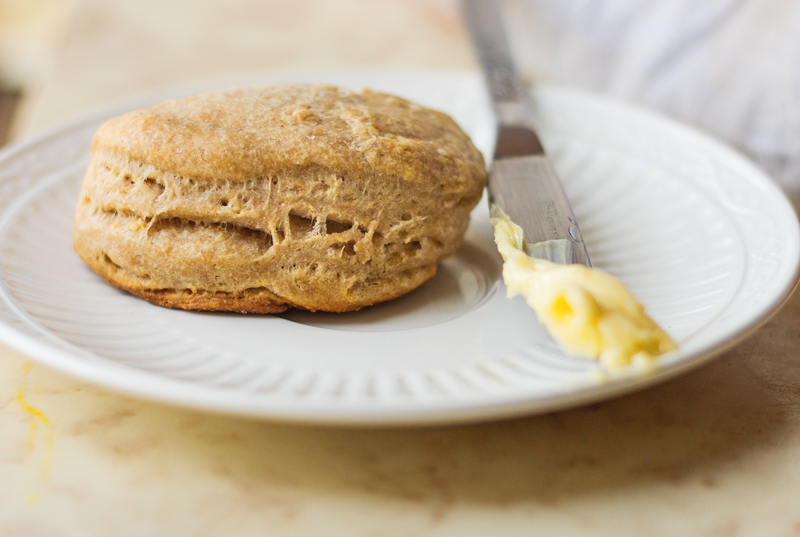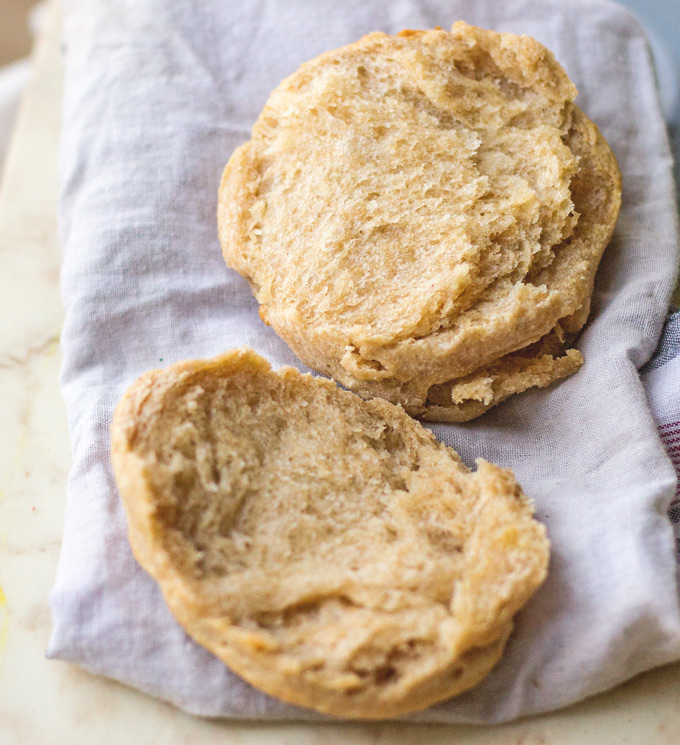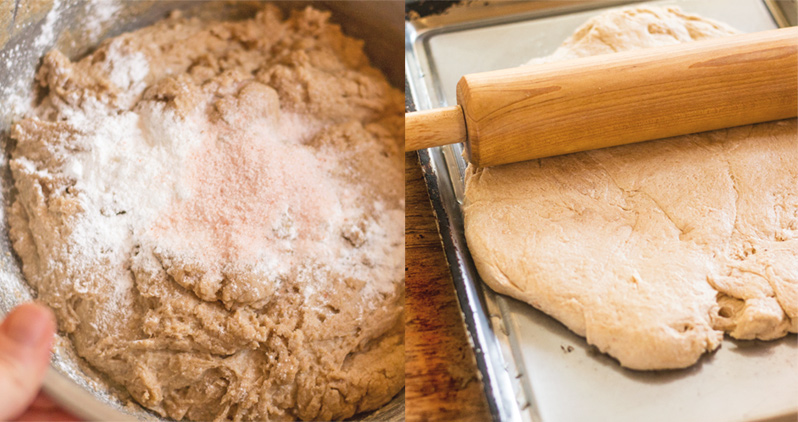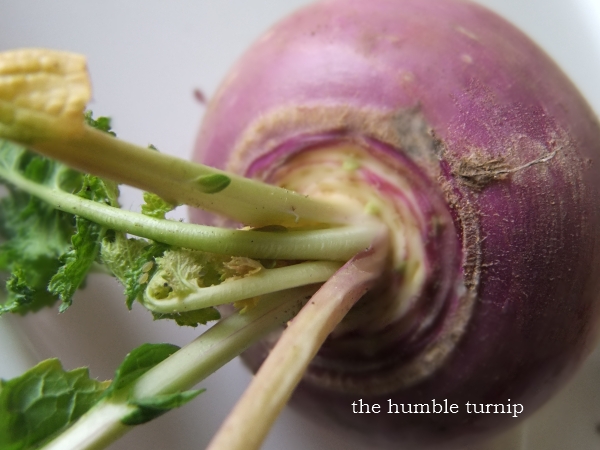Kefir-Soured Biscuits

My sourdough starter kicked the bucket about a month ago… or, more accurately, I brought about its demise through sheer neglect. Still, not one member of the bread-eating family was prepared to say good-bye to fermented bread and just about that same time, with plenty of milk between Mabel and the goats, milk kefir was back up and running in our kitchen.
Milk kefir is probably my favorite fermented food, in case you hadn’t picked that up here on the blog or in Traditionally Fermented Foods. I use it for drinking, salad dressings, desserts, snacks, to ferment whole grains, and to sour breads. It is one of those foods that seem to really encourage gut health, energy, and nourishment so it has become a staple in our home when we are in milk.
So I started making kefir-soured tortillas and these lovely biscuits on a regular basis. They are flaky and tender, tangy and light, with just a bit of a crisp edge as one would want in a biscuit. I ferment them overnight, generally, but you can extend that to a full 24-hour fermentation if you prefer.

In the morning I put on a kettle for coffee and the morning milking. I preheat the oven, hand Stewart the milk pail, and then start rolling out these biscuits right on the baking sheet. The biscuits are golden and flaky by the time the cow and goats are milked, the chickens out and fed, and the family gathered around the table. It is at this point I am dishing up homegrown eggs from a cast-iron skillet and sitting down to join them.
Somehow even though I’ve made these over a dozen times this past month, this family of mine still doesn’t seem to be growing tired of them. And the milk kefir appreciation continues…
Kefir-Soured Biscuits

Ingredients
- 1.5 cups cultured milk kefir
- 3.5 cups bread flour (we like this variety of Heritage Wheat Bread Flour)
- 1/2 cup softened butter or coconut oil
- 1.5 teaspoons salt
- 1 Tablespoon aluminum-free baking powder
Directions
At least 12-24 hours before you wish to bake the biscuits, combine the kefir, bread flour, and softened butter or coconut oil in a medium bowl. Mix all ingredients just until roughly combined and the flour is moistened. Cover and leave to ferment at room temperature for 12-24 hours.
When ready to bake, preheat the oven to 450 degrees and grease a baking sheet generously.
Uncover the fermented dough and sprinkle over the salt and baking powder. Fold the dough over onto itself (and the salt and baking powder) several times, breaking up the dough and kneading until the salt and baking powder seem well distributed.
Transfer the dough right to the greased baking sheet and roll out to 1/2 – 3/4 inch thickness using a rolling pin. Cut the biscuits into squares using a knife or bench scraper or into rounds using a biscuit cutter or narrow-mouth canning ring. Gently gather up any scraps and form a few extra biscuits.
Move the pan to the oven and bake 20-25 minutes or until deeply golden on the bottom and brown and crisp around the edges. Allow to cool at least five minutes before serving.
For more easy-to-make naturally leavened breads, including a Sourdough Biscuit recipe that uses only sourdough starter as leavening, see Traditionally Fermented Foods.


Oh, these look lovely. Have you experimented with a wheat free version of these.
CShines – I have not but there is a recipe for wheat-free soured biscuits in 100% Rye and a completely gluten-free Sourdough English Muffin recipe in Traditionally Fermented Foods that we really like.
Well I’ll have to pull out my copy of 100% Rye. I have only cracked the cover a few times. I’ve been waiting for my kitchen to be finished before I dive into the world of sourdough starters. But I’ll make sure to check both of my books out.
Thanks.
Lovely post. Thank you for the flour recommendation. I am always looking for flour that is ancient grains & not through the roof expensive. I will try this the next time I buy flour.
These look delicious! A couple questions: How is bread flour different than regular flour? Can this recipe be adapted for using freshly ground rye or spelt flour?
Katie – Generally bread flour has more protein (gluten) than all-purpose flour. You could probably use AP flour, I just have only tested the recipe on bread flour. I think freshly ground spelt would work well but it absorbs a different amount of moisture so I would start with 25% less kefir and see how stiff the dough gets from there. There is a recipe for Sourdough/Soaked Rye Biscuits in my book 100% Rye and they are very tasty. 🙂
Thanks! Your book is on my wish list! We’ll see what I can do with this recipe for now. =)
Katie – Great! Let us know if you give it a go.
Hi! I am new to using kefir for anything other than smoothies, but I had neglected it for over a week and am looking for a way to use it. My question is: do you strain the kefir and use that to ferment the flour and coconut oil or just use the whey from the kefir? Thankyou for your help.
Hi Ruth!
Yes, we strain the kefir from the grains and use that cultured kefir to sour the biscuits. You could also use the whey from strained kefir, if you happen to have it, but whole milk kefir makes for a richer biscuit.
Thankyou! I look forward to making these.